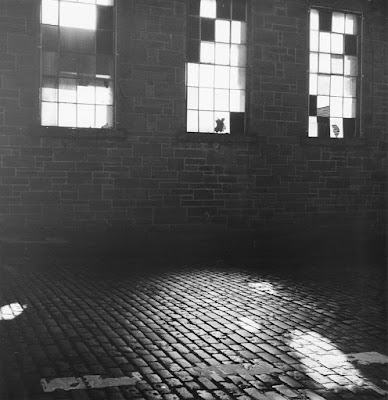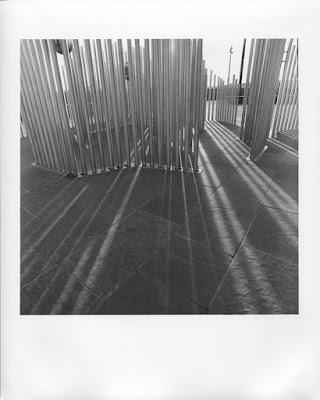Morning folks - I hope you are all feeling tip-top and chipper, rather than feeling you've done 15 rounds with 18 white pudding suppers from The Chipper (you'll only get that if you're East Coast Scottish).
Hmmm - what's that lovely smell?
It certainly isn't the wonderful aroma of diluted acetic acid liberally sloshed all over freshly-fried potatoes along with enough salt to construct a model of a Leica M2 . . nor is it that heady mixture of deep fried batter, fish and cigarette smoke drifting down the prevailing breeze on the Blackie!
(Again, you'll only get that if you've ever been to the nether-regions of Dundee).
No!
It's the smell of change.
God.
AT LAST!
 |
| Ghost Of A Jute Mill |
We were recently on a short but lovely family holiday to York.
It was great, but seeing as we've done the place to death, this time, we explored more of the older pubs, of which there are quite a few. I am now actually of a mind to think, you can really get the measure of a place from its older pubs.
We did the same in Brussels last year and it was eye-opening.
However the smell of change wasn't just that wonderful afternoon feeling of a couple of pints and some really good chat. No.
It was the curious metallically-musty smell of a newly opened camera back!
Yep - film cameras.
I saw THREE.
This is a new record for a trip away (I have recorded the film cameras I've seen on holiday religiously for years) so I can only assume that there's a fresh breeze whistling up the kilts of enthused amateurs like myself.
How is it in your part of the world?
A couple of months back, I accosted a chap on Dundee's High Street, because he was carrying a Leica M6.
I know, the sheer affrontary, but I couldn't just let him walk on by.
I had my Rollei with me, so it was very much a case of 'show me yours and I'll show you mine'.
He also said:
"You're not that bloke from here that writes that blog are you?"
Outed.
I couldn't believe it.
And if you are reading this, hail and well-met squire!
Then in York, THREE film cameras:
A Praktika; a small rangefinder and an ME Super (so surprised was I by seeing that, that I actually walked up to the young woman and admired it - she said she loved it and it had been her fathers).
Include me with an M2/35mm Summaron and that's a few cameras.
And then, last week, I was out with the Mamiya C330, wasting a roll of Tri-X with a view to pushing it to 800 and developing it in Rodinal (sic) at 1+100.
The pics were crap but the experiment worked.
And there I was, standing in Blackscroft, wondering what to point my lens at, when a young woman shouted across the road at me:
"MEDIUM FORMAT!"
I was so shocked my false teeth nearly shot out.
I said "Pardon?" and again she said "Medium Format" to which I said "Yes!"
I crossed the road and asked her if she was a film user and indeed she was, a Pentax K1000 and she "loved it"!
As we parted I shouted:
"Never stop using film."
and she said:
"I won't, I love it!"
I was chuffed as a chuffing chuffer in a chuffed-up competition. This is fantastic.
 |
| Tri-X Ei 800, 1+100 Rodinal and Red Filter. Mamiya C330 + 80mm f2.8 |
 |
| Tri-X Ei 800, 1+100 Rodinal and Red Filter. Mamiya C330 + 80mm f2.8 |
I am pleased though, I'll tell you that.
Myself and all the wee bloggers like myself who have been banging on about film for years . . maybe we've just been preaching to the wrong sorts, because in that time there's been a groundswell, albeit small, in people finding that actually film is fun, satisfying and educational in a skill-set sort of way.
Gosh - I hope we get badges or something.
There's an amendum to this - I've said before that I frequent Dundee's DCA Photography Forum - it's always been great, though I am one of the very few film users and pretty much the only darkroom user. Well, last time, there was a chap there who said he's just recently made his first darkroom prints and couldn't wait to get back in and make some more (he uses the DCA's own hireable darkroom).
Oh boy, I was in heaven.
Someone I can talk to about printing.
And maybe that's where this wee upswell could continue growing.
Home darkrooms.
Or public ones, but home ones are good - there's no time pressures.
You know in recent times I've seen not-that-old Meopta Medium Format enlargers selling for well under £100.
Now probably people in the market for an enlarger are thinking:
'Oh no, I NEED a DeVere, or a Kaiser or something with a Heiland head or stuff like that.'
To which I will say to you - YOU EMPHATICALLY DO NOT!
Meoptas' (or older Dursts or LPLs, or even a good condition Leitz) are actually excellent little enlargers - very well made and solid with everything you need and nothing you don't.
They're simple.
Like printing.
It is a really easy process and does not need super-computers or professional analysers to deal with exposing a bit of coated paper.
Sure you can go as complex as you want, obviously, but in the initial stages it is all about learning the craft, and that doesn't have to be too expensive if you move along the RC paper route ***.
What printing does need, is enthusiasm; an ability to take some (sometimes) considerable knocks in confidence, but above all else an ability to take it on the chin and keep going. That doesn't sound like FUN but I swear to you that it is - it's wonderful actually and in my opinion at least half of what makes you a 'photographer' - well it is at least half of what makes me a photographer.
Anyway, that's an aside.
Things are moving.
*** As an aside to this I urge Ilford to please watch the pricing on paper, because it would be quite easy to kill 'wet' printing stone dead. Having just been financially crippled from ordering 125 sheets of 8x10 MGFB, it doesn't half make you think twice; AND that's me speaking as a really enthusiastic printer . . . so Harman/Ilford, please . . watch it.
I'll not say much more than this:
If you are new to 'traditional' photography, Hello! well done, it's fun and hard work, but more the former than the latter.
It can be as easy or as difficult as you wish, but that's up to you.
At the end of the day it is ALL about expressing yourself.
It might not be obvious, but that small miracle of metal/plastic/emulsion and glass that you're holding is a portal to creativity and self-expression.
It's a time machine, a black hole and a conduit all at once.
It can frustrate and delight all on the same roll!
Use it wisely and it can give you decades of pleasure (as long as they keep manufacturing film and paper).
Treat it with respect and pleasure and it will repay you in spades.
In short, it's a wonderful thing.
And that's it - of course this could all be a herd of bullocks and a mere blip in the coincidence/time continuum, however, for the moment . . .
There y'go - unusually for me - briefer than an ill-fitting pair of 1970's mustard-yellow Y-fronts.
Good luck folks!
Much love and respect.
H xx
.jpeg)

.jpeg)
.jpeg)
.jpeg)
.jpeg)
.jpeg)
.jpeg)

.jpeg)
.jpeg)



.jpeg)
.jpeg)
.jpeg)
.jpeg)
.jpeg)
.jpeg)
.jpeg)
.jpeg)







